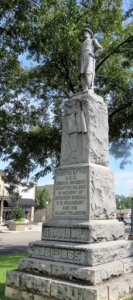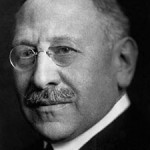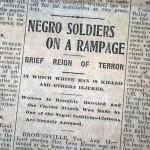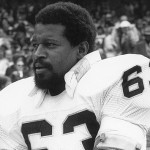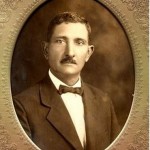Essay
Our democracy’s founding ideals were false when they were written. Black Americans have fought to make them true.
Image: Artwork by Adam Pendleton
(The New York Times Magazine) In August 1619, just 12 years after the English settled Jamestown, Va., one year before the Puritans landed at Plymouth Rock and some 157 years before the English colonists even decided they wanted to form their own country, the Jamestown colonists bought 20 to 30 enslaved Africans from English pirates. The pirates had stolen them from a Portuguese slave ship that had forcibly taken them from what is now the country of Angola. Those men and women who came ashore on that August day were the beginning of American slavery. They were among the 12.5 million Africans who would be kidnapped from their homes and brought in chains across the Atlantic Ocean in the largest forced migration in human history until the Second World War. Almost two million did not survive the grueling journey, known as the Middle Passage.
Before the abolishment of the international slave trade, 400,000 enslaved Africans would be sold into America. Those individuals and their descendants transformed the lands to which they’d been brought into some of the most successful colonies in the British Empire. Through backbreaking labor, they cleared the land across the Southeast. They taught the colonists to grow rice. They grew and picked the cotton that at the height of slavery was the nation’s most valuable commodity, accounting for half of all American exports and 66 percent of the world’s supply. They built the plantations of George Washington, Thomas Jefferson and James Madison, sprawling properties that today attract thousands of visitors from across the globe captivated by the history of the world’s greatest democracy. They laid the foundations of the White House and the Capitol, even placing with their unfree hands the Statue of Freedom atop the Capitol dome. They lugged the heavy wooden tracks of the railroads that crisscrossed the South and that helped take the cotton they picked to the Northern textile mills, fueling the Industrial Revolution. They built vast fortunes for white people North and South — at one time, the second-richest man in the nation was a Rhode Island “slave trader.” Profits from black people’s stolen labor helped the young nation pay off its war debts and financed some of our most prestigious universities. It was the relentless buying, selling, insuring and financing of their bodies and the products of their labor that made Wall Street a thriving banking, insurance and trading sector and New York City the financial capital of the world.
But it would be historically inaccurate to reduce the contributions of black people to the vast material wealth created by our bondage. Black Americans have also been, and continue to be, foundational to the idea of American freedom. More than any other group in this country’s history, we have served, generation after generation, in an overlooked but vital role: It is we who have been the perfecters of this democracy. (more)
Texas Students Will Learn That the Civil War Was About Slavery. Sort of.
(Dallas Observer) Beginning this fall, Texas students will learn a fact that’s as true today as it was in 1861: Texas and the 10 other states that made up the Confederacy seceded from the Union over the issue of slavery.
New state social studies standards for fifth and seventh grades require students to be able to explain slavery’s central role in the Civil War. Previous standards, adopted in 2010, downplayed slavery as the main reason Texas joined the Confederacy, listing it among a number of issues that led to the war, after states’ rights and sectionalism.
The change is part of a revision of the Texas Essential Knowledge and Skills, or TEKS, the state’s standards for public schools. While the new fifth-grade standards still list states’ rights and sectionalism as factors in the war, they’re presented as secondary issues that emerged as a result of the expansion of slavery. The change represents a compromise between Democrats on the Texas State Board of Education who wanted to elevate slavery to its correct place as the war’s central cause and Republicans who wanted to keep states’ rights in the curriculum. (more)
Photo: A statue of Confederate Brig. Gen. Hiram Bronson Granbury stands in front of the Hood County Courthouse in Granbury, Texas. (Getty Images)
Black College Football Hall of Fame Announces 2019 Black College Football Player of the Year Award Watch List
Three PVAMU players are noted
The Black College Football Hall of Fame (BCFHOF) announced today the 2019 Watch List for the Black College Football Player of the Year Award. The Award is presented annually to the most outstanding football player from a Historically Black College & University. Former North Carolina A&T, and current Chicago Bears running back Tarik Cohen was selected as the inaugural recipient of the Award in 2016; Bowie State quarterback Amir Hall was the 2017 and 2018 recipient.
Three PV Panthers were named to the list: Jalen Morton, quarterback; Ju’Anthony Parker, defensive back; and Dawonya Tucker, running back. All three players are seniors.
The winner of the 2019 Black College Football Player of the Year Award will be honored with the Deacon Jones Trophy during the Black College Football Hall of Fame Induction Ceremony, which takes place on February 15, 2020 in Atlanta. Four finalists will be unveiled on December 3, 2019.
The Watch List candidates have been selected based on past performance and future potential. Additions to the list may be made as the 2019 season progresses. The finalists and the winner will be chosen by a Selection Committee. (more)
TIPHC Bookshelf
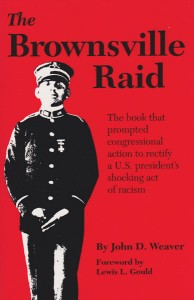 Published scholarship on black history in Texas is growing and we’d like to share with you some suggested readings, both current and past, from some of the preeminent history scholars in Texas and beyond. We invite you to take a look at our bookshelf page – including a featured selection – and check back as the list grows. A different selection will be featured each week. We welcome suggestions and reviews. This week, we offer, “The Brownsville Raid,” by John D. Weaver.
Published scholarship on black history in Texas is growing and we’d like to share with you some suggested readings, both current and past, from some of the preeminent history scholars in Texas and beyond. We invite you to take a look at our bookshelf page – including a featured selection – and check back as the list grows. A different selection will be featured each week. We welcome suggestions and reviews. This week, we offer, “The Brownsville Raid,” by John D. Weaver.
Around midnight on August 13, 1906, shots rang out on the road between Brownsville, Texas, and Fort Brown, the old army garrison. Ten minutes later a young civilian lay dead, and angry residents swarmed the streets, convinced their homes had been terrorized by newly arrived soldiers. Inside Fort Brown, the alarm was sounded. Soldiers leaped from their bunks and grabbed their rifles, thinking they were under attack by hostile townspeople. The soldiers were black; the civilians were white.
Still proclaiming their innocence, 167 black infantrymen of the segregated Twenty-fifth Infantry Regiment were summarily dismissed without honor (or a trial) by President Theodore Roosevelt.
The Brownsville Raid, first published in 1970, is John D. Weaver’s searching study of the flimsy evidence presented in a 1909-1910 court of inquiry. That court had upheld the president’s action and closed the case against the soldiers, not one of whom had ever been found guilty of wrongdoing. The case remained closed until 1971 when, after reading The Brownsville Raid, Congressman Augustus F. Hawkins of Los Angeles introduced a bill to have the Defense Department rectify the injustice.
Amid a flurry of national publicity, honorable discharges were finally granted in 1972. All were posthumous except for that of Private Dorsie Willis, who received his in a moving ceremony on his eighty-seventh birthday.
This Week in Texas Black History
Aug. 11
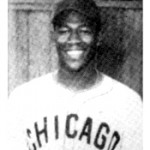 On this date in 1922, Negro Leagues star and Tuskegee Airman John “Mule” Miles was born in San Antonio. Miles attended Phillis Wheatley High School, then served as a mechanic for the 99th Pursuit Squadron. After that, Miles played for the Chicago American Giants from 1946 to 1949 and in 1947 hit 11 home runs in 11 straight games, a feat that has never been equaled. He played alongside such greats as Jackie Robinson, Hank Aaron, Ernie Banks and Satchel Paige. Giants’ manager Candy Jim Taylor, gave Miles his nickname saying that he “hit like a mule kicks.” Among his many honors, Miles was inducted into the Texas Black Sports Hall of Fame in 2000, to the San Antonio Sports Hall of Fame in 2003, to the Texas Aviation Hall of Fame in 2009, and to the Prairie View Interscholastic League Coaches Association Hall of Fame in 2010.
On this date in 1922, Negro Leagues star and Tuskegee Airman John “Mule” Miles was born in San Antonio. Miles attended Phillis Wheatley High School, then served as a mechanic for the 99th Pursuit Squadron. After that, Miles played for the Chicago American Giants from 1946 to 1949 and in 1947 hit 11 home runs in 11 straight games, a feat that has never been equaled. He played alongside such greats as Jackie Robinson, Hank Aaron, Ernie Banks and Satchel Paige. Giants’ manager Candy Jim Taylor, gave Miles his nickname saying that he “hit like a mule kicks.” Among his many honors, Miles was inducted into the Texas Black Sports Hall of Fame in 2000, to the San Antonio Sports Hall of Fame in 2003, to the Texas Aviation Hall of Fame in 2009, and to the Prairie View Interscholastic League Coaches Association Hall of Fame in 2010.
Aug. 11
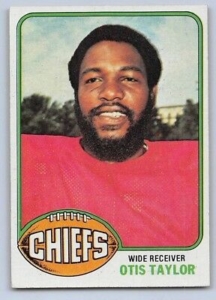 Kansas City Chiefs wide receiver Otis Taylor was born on this day in 1942 in Houston. Taylor attended E.E. Worthing HS where he starred in football and basketball. At Prairie View A&M, Taylor was a member of the Panthers’ 1963 and 1964 Black College National Championship teams. He was a fourth round draft pick of the Chiefs where Taylor would spend his entire AFL/NFL career (1965-1974). He remains the Chiefs second-leading receiver in career touchdowns (57) and is No. 4 on their list for all-time receiving yards (7,306). He scored a dynamic catch-and-run touchdown in Kansas City’s 23-7 upset win over the Minnesota Vikings in Super Bowl IV. Taylor was twice named an All-Pro.
Kansas City Chiefs wide receiver Otis Taylor was born on this day in 1942 in Houston. Taylor attended E.E. Worthing HS where he starred in football and basketball. At Prairie View A&M, Taylor was a member of the Panthers’ 1963 and 1964 Black College National Championship teams. He was a fourth round draft pick of the Chiefs where Taylor would spend his entire AFL/NFL career (1965-1974). He remains the Chiefs second-leading receiver in career touchdowns (57) and is No. 4 on their list for all-time receiving yards (7,306). He scored a dynamic catch-and-run touchdown in Kansas City’s 23-7 upset win over the Minnesota Vikings in Super Bowl IV. Taylor was twice named an All-Pro.
Aug. 12
In 1862, Julius Rosenwald was born in Springfield, Ill. In 1917, as president of Sears and Roebuck, he established the Julius Rosenwald Fund to support educating black children. His belief was that America could not prosper “if any large segment of its people were left behind.” His fund paid for the construction of more than 5,000 schools (“Rosenwald Schools”) in 15 southern states to educate blacks, including 464 schools in Texas that impacted 57,330 students.
Aug. 13-14
In 1906, at Fort Brown, in Brownsville, Texas, members of the all-black 25th Infantry regiment supposedly killed a bartender and wounded a policeman, both white, the night after a white woman had reportedly been attacked by black soldiers. The men of the 25th denied participating in any of the incidents. However, despite dubious testimony from Brownsville citizens, President Theodore Roosevelt presumed the mens’ guilt and issued the largest summary dismissal in U.S. Army history as three companies (167 men) were dishonorably discharged. However, in 1972, U.S. Congressman Augustus Hawkins (D-CA) successfully had the discharges reversed to “honorable.”
Aug. 14
Alta Vista Agricultural and Mechanical College of Texas for Colored Youth” was established by the Fifteenth Legislature of Texas on this day in 1876. The school would become Prairie View A&M University, the first state supported College in Texas for African Americans. The Texas Constitution of 1876, in separate articles, established an “Agricultural and Mechanical College” and pledged that “Separate schools shall be provided for the white and colored children, and impartial provisions shall be made for both.”
Aug. 15
In 1945, Gene Upshaw was born in Robstown, Texas. Upshaw was an All-America lineman at Texas A&I University (now Texas A&M-Kingsville), from 1963-66. He was a first-round draft pick of the Oakland Raiders in 1967 and for his 15-year career played on two Super Bowl winning teams. After his playing career, he became executive director of the National Football League Players’ Association and, in 1987, was inducted into the Pro Football Hall of Fame.
Aug. 16
Surgeon Lee Gresham Pinkston was born on this day in 1883 in Forest, Mississippi. He received his M.D. degree at Meharry Medical College in Nashville, Tenn. He moved to Terrell, Texas in 1910 to begin private practice and later opened a clinic and drugstore. In 1927, he opened the Pinkston Clinic Hospital, which was the only operating clinic serving the African American community. He was the first of five African American doctors on the staff of Dallas’ St. Paul Hospital, where he remained until his death in 1961. Pinkston High School in Dallas is named in his honor. In 1936, Pinkston helped found the Democratic Progressive Voters League, one of the oldest black political organizations in the state of Texas.
Aug. 16
Austin’s historic Victory Grill was opened on this day in 1945 (Victory over Japan Day) by band manager Johnny Holmes in a converted ice house as a venue for African American servicemen on R&R as well as those returning from World War II. The restaurant and night club became known for its blues and jazz music as well as its food and drink and attracted multi-racial crowds. At its peak, in the 1950s, most of the popular national R&B and jazz acts performed at the Victory Grill as part of the “Chitlin’ Circuit,” including Ike & Tina Turner, James Brown, Etta James, Billie Holiday, Chuck Berry, and Janis Joplin.
Blog: Ron Goodwin, Ph.D., author, PVAMU history professor
Ron Goodwin is an assistant professor of history at Prairie View A&M University. Even though he was a military “brat,” he still considers San Antonio home. Like his father and brother, Ron joined the U.S. Air Force and while enlisted received his undergraduate degree from Texas Lutheran University in Seguin, Texas. After his honorable discharge, he completed graduate degrees from Texas Southern University. Goodwin’s book, Blacks in Houston, is a pictorial history of Houston’s black community. His most recent book, Remembering the Days of Sorrow, examines the institution of slavery in Texas from the perspective of the New Deal’s Slave Narratives.
Recent Posts
The beginning of the end: D-Day
In June 1944, Allied forces began their assault not only on the beaches of Normandy, but on Nazism itself. Dubbed Operation Overlord, the amphibious exercise is legendary as the extraction of France from German control and the beginning of the end of Adolph Hitler’s plans for a thousand year reign of his Aryan master race. The death tolls were staggering on the initial day of the operation. Thousands of Americans gave the greatest sacrifice in…(more)
Hidden In Plain Sight
In 1903, W.E.B. Du Bois wrote The Souls of Black Folk in which he claimed: “the problem of the Twentieth Century is the problem of the color-line.” That was 1903. American society is in the last year of the second decade of the twenty-first century, and I wonder if that famous quote still applies. In 1903, Jim Crow dominated every aspect of American life and forced the black community into the shadows. Du Bois used”…(more)
Submissions wanted
Historians, scholars, students, lend us your…writings. Help us produce the most comprehensive documentation ever undertaken for the African American experience in Texas. We encourage you to contribute items about people, places, events, issues, politics/legislation, sports, entertainment, religion, etc., as general entries or essays. Our documentation is wide-ranging and diverse, and you may research and write about the subject of your interest or, to start, please consult our list of suggested biographical entries and see submission guidelines. However, all topics must be approved by TIPHC editors before beginning your research/writing.
We welcome your questions or comments. Please contact Michael Hurd, Director of TIPHC, at mdhurd@pvamu.edu.

